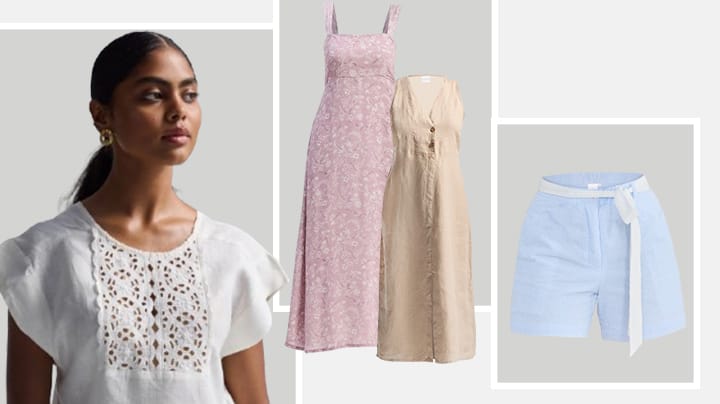Looking good is not enough anymore. Consumers today seek fashion with values. Consumers today choose eco-friendly fashion options because they offer both style and environmental benefits. The fashion essentials of the summer season emerge from sustainable production methods and natural materials combined with conscious purchasing habits.
Every collection requires the right fabric to serve as its essential foundation. The design vision becomes reality when it determines the fit, flow, and feel of each garment. The mood of a fashion collection emerges through its fluidity, breathability, and texture.
Global fashion brands demonstrate how sustainable materials can integrate with luxury fashion through their organic cotton dresses and airy hemp ensembles. These are the leading eco-friendly fashion discoveries that characterize summer 2025.
Organic Cotton Dresses
This season organic cotton dominates fashion trends. The fabric provides comfort without compromise. Nothing beats the sensation of wearing a soft cotton dress that breathes freely during summer heat. Fashion brands now focus on classic silhouettes along with flowing midis and easy-to-wear shirt dresses while ensuring all their materials are ethically sourced.
Traditional cotton farming requires a large amount of natural resources. Organic cotton stands out because it relies on rain-fed irrigation and avoids synthetic pesticides during growth. Organic cotton provides lasting strength while being kind to your skin and beneficial to the environment.
Look for understated design details which include sustainable textiles and natural dyes combined with unstructured cuts for enhanced mobility in clothing.
Hemp and Linen Matching Sets/Separates
In 2025 two of fashion’s most ancient and eco-friendly textiles hemp and linen are experiencing a powerful resurgence.
Fashion designers value the light weight and breathable qualities of hemp and linen. Fashion designers create stylish matching sets along with flowy wide-leg pants and structured relaxed blazers. These items provide multiple wearing options that perform equally well in day and evening settings.
The environmental benefits of hemp and linen textiles are highlighted by their minimal water requirements during cultivation and their tendency to soften over time with use. Linen creates natural elegance through its subtle wrinkles while hemp provides lasting durability which makes these materials essential for a thoughtfully assembled wardrobe.
Natural Dye Prints- Earthy and Artisanal
Natural dyeing techniques provide an eco-friendly enhancement to summer shades and prints. By using botanical and plant-based dyes designers can create prints without generating harmful chemical waste or pollution. This season’s fashion will showcase sun-kissed yellows combined with deep indigos and warm terracottas featured on casual wear and relaxed kaftans. Artisanal prints that use hand-dyeing methods provide fashion with exclusive and singular elements. They celebrate craftsmanship and tradition. These pieces stand out visually. These fashion pieces embody both heritage and slow fashion ideals while demonstrating meticulous care.
Loungewear
The line between homewear and outerwear continues to blur in 2025, with luxurious yet effortless loungewear sets redefining summer fashion. Ultra-soft knit separates, relaxed jumpsuits, and flowy palazzo pants in breathable fabrics allow wearers to feel at ease while looking put together.
Sustainably sourced bamboo, organic cotton blends and modal fabrics are leading this movement, offering a gentle touch on the skin and a reduced impact on the planet. Think lounge sets in neutral palettes, soft pastels, and earthy tones, perfect for slow mornings, casual brunches, or even a spontaneous night out.
Eco-Friendly Swimwear
The ideal summer wardrobe must include the perfect swimsuit which this year features innovative designs from brands using recycled ocean plastic and regenerated nylon. New materials effectively turn discarded waste into advanced textiles which provide classic swimwear-like sleekness and sculpting features.
This season will showcase swimwear featuring simple cuts alongside asymmetrical designs which display sophisticated colors that take inspiration from nature. Imagine colors of the deep ocean paired with sandy beaches and natural earth tones. Modern swimwear production takes place in factories that provide fair wages and operate ethically while achieving sustainability beyond material use.
The Future of Sustainable Summer Fashion
The fashion industry is shifting toward a new model which combines luxury with ethical principles. Summer 2025 demonstrates that sustainable fashion practices have become the norm instead of just an option. More fashion brands are now focusing on ethical production for high-quality pieces that support both innovative design and environmental responsibility so customers can dress stylishly and make ethical purchases.
Our discussion should turn to organic cotton dresses, hemp separates, and naturally dyed prints because they represent the winning approach. Sustainable fashion has become an integral component of everyday living. The U.S.-based brand Reistor leads its industry through understated actions by producing garments that adhere to slow fashion principles.
The rise in consumer demand for sustainable products illustrates how eco-friendly fashion trends from Summer 2025 show sustainability as a permanent shift. It is the future of fashion.


